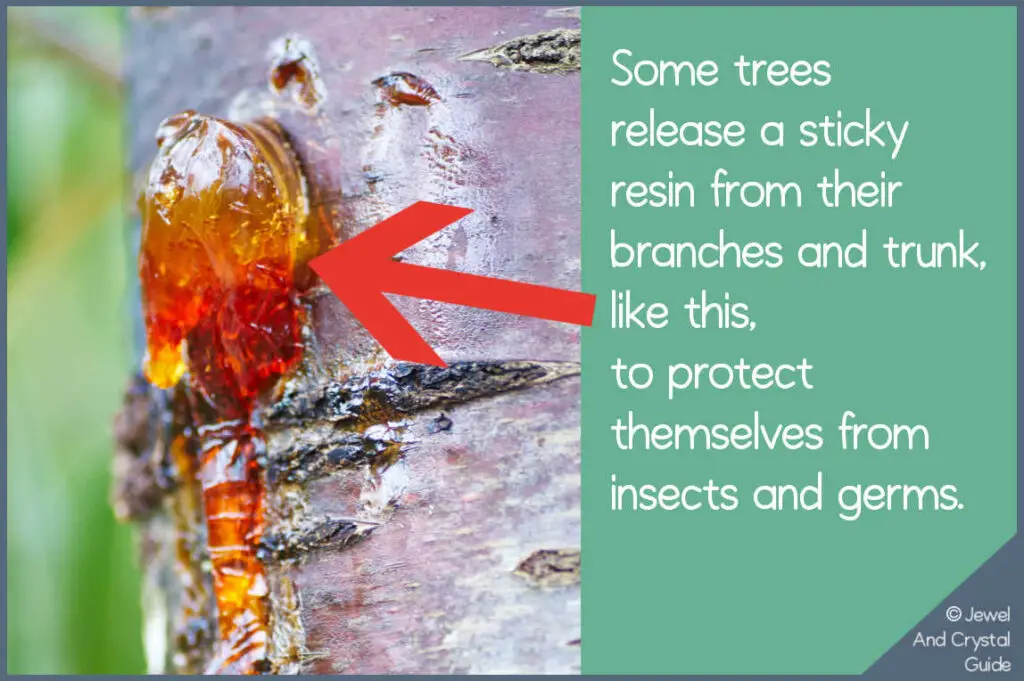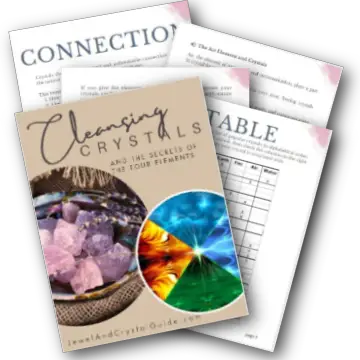Are you ready to step into a world where time is frozen and nature’s artwork has been preserved for millions of years? Let me introduce you to Baltic amber, a treasure that holds within it great secrets of the past.
Baltic amber, also known as succinite and true amber, is found in the Baltic region, particularly along the shores of the Baltic Sea. It is highly valued for its beauty and historical significance, including its remarkable preservation of ancient life forms.
Let’s unveil this prehistoric world and explore how Baltic amber formed and why, what makes Baltic amber different than regular amber, and how much it costs to own a piece of history.
In this blog post, you’ll discover:
- How Baltic amber formed
- Where Baltic amber is found
- Why there’s so much amber in the Baltic
- The difference between Baltic amber and regular amber
- Where to buy Baltic amber
- How much Baltic amber costs
- How to tell if Baltic amber is real
How Baltic amber formed
Baltic amber formed from the resin of ancient coniferous trees in the area, most notably a now-extinct species called Sciadopitys. These trees released an enormous amount of sticky resin to protect themselves against pests, injuries, or environmental stresses (which some trees still do today, but in much smaller quantities).

The resin flowed down the tree, sometimes trapping things like insects, plant matter, and even whole small vertebrates in its sticky goo. The resin landed on the ground, got covered by soil, and sat there protected from the sun and weather.
Over time, the resin got compounded by the soil and underwent a process called “polymerization.” This process is important because it’s what turned the resin into amber.
Polymerization is a transformation in the resin, where the liquid form changes into a solid. This happens because under the right conditions, molecules inside the resin start linking together. The linked molecules form long chains, similar to how beads on a necklace connect to make a longer chain.
As time goes by, more and more molecules join the chain, making it longer and stronger. This process can take millions of years!
When polymerization is complete, it’s no longer resin but a beautiful, golden solid and a fossil, and we call it Baltic amber.
Where Baltic amber is found
Baltic amber is found in the Baltic Amber Belt, also known as the Amber Coast. This Belt includes several countries on the south-eastern shores of the Baltic Sea, and is collectively made up of Lithuania, Kaliningrad (a Russian Oblast), Poland, and Latvia.

Let’s take a closer look at the countries that are part of the Baltic Amber Belt:
- Lithuania: Lithuania is one of the primary countries associated with Baltic amber. It has extensive amber deposits along its Baltic coastline, particularly in the regions of Palanga and Juodkrantė.
- Russia: The Kaliningrad Oblast, a Russian exclave located between Poland and Lithuania, is another significant region within the Baltic Amber Belt. The coastal areas of Kaliningrad have notable amber deposits.
- Poland: Poland has its share of Baltic amber deposits along its Baltic Sea coastline, particularly in regions such as the Sambia Peninsula and Pomerania.
- Latvia: While not as well-known as Lithuania, Latvia also has amber deposits along its Baltic coastline. The region of Jūrmala is known for its amber finds.
Why there’s so much amber in the Baltic Amber Belt
The formation of Baltic amber dates back millions of years to the Eocene epoch, which lasted from approximately 56 to 33.9 million years ago.
The unique conditions in the Baltic region played a crucial role in the formation of Baltic amber all those years ago:
The region was once covered by dense forests of resin-producing coniferous trees, which are evergreen trees that have needle-like leaves and usually yield pine cones.
The sea was also shallow and salty in the area, making it the perfect place for resin to be deposited and preserved in the ground, where it had time to fossilize into amber.
The difference between Baltic amber and regular amber
“Baltic amber” refers to amber found in the Baltic region, primarily along the south-eastern shores of the Baltic Sea. “Regular amber” or just “amber” is a general term that includes all types of amber found around the world.
Here are some key differences between Baltic amber and regular amber:
Geographic origin
Baltic amber is exclusive to the Baltic region, including countries such as Lithuania, Russia (Kaliningrad Oblast), Poland, and Latvia.
Regular amber can be found in various locations globally, including the Dominican Republic, Mexico, Myanmar (Burma), Canada, and others.
Age
Tree resin must be at least 10 million years old to be called amber, whether it’s Baltic amber or regular amber.
Baltic amber is generally younger than other types of amber, though this is relative because amber already is millions of years old! Baltic amber originated from the Eocene epoch, making it approximately 33 to 56 million years old.
Depending on where it’s found, regular amber can come from the Cretaceous, Jurassic, or Paleogene periods. These periods span from approximately 66 to 252 million years ago. So regular amber can have an average age ranging from a few million years to over 100 million years, depending on the specific region and deposit.
Fossil inclusions
Inclusions in amber are any objects or materials that were trapped and preserved within the fossilized resin.
Baltic amber is renowned for its exceptional fossil inclusions. It has an extensive and diverse array of well-preserved insects, plants, and other organisms trapped within it, most of which are now extinct.
Regular amber from other locations may also contain inclusions, but the abundance and variety of the inclusions in Baltic amber are particularly notable.
Appearance
Baltic amber has a fairly consistent appearance. Most Baltic amber is a warm, golden color ranging from pale yellow to rich orange or reddish-brown. It often has a high translucence, making it quite see-through or transparent. This lets light pass through the stone and gives it a beautiful glow – and sometimes even sparkles.
The appearance of regular amber depends on its origin, and it comes in a wide range of colors. For example, Dominican amber comes in golden-yellow, red, green, blue, and even rare black varieties. And Canadian amber tends to have a warm, honey-like color ranging from pale yellow to deep orange-brown.
Levels of succinic acid
Succinic acid, also known as amber acid, is an organic compound found in amber. This acid helps to form and preserve the amber, and it protects the fossilized inclusions inside the amber.
Baltic amber has more succinic acid in it than regular amber. Baltic amber is made up of about 3% to 8% succinic acid, and sometimes even more than that.
While there is no universal percentage range, it is estimated that succinic acid ranges from trace amounts up to around 3% of regular amber. This is a rough estimate and depends on the specific deposit and the amber’s age.
Where to buy Baltic amber
Because amber is so valuable, there’s a lot of fake amber on the market. These fakes are made of glass, plastic, copal, resins, and some other materials. If you want to be sure you are buying real Baltic amber, buy from a reputable source and ask for proof of the amber’s authenticity.
Baltic amber can be purchased from various places, including online retailers, jewelry stores, and specialty shops. Here are some options for buying Baltic amber:
Online retailers
Numerous online platforms specialize in selling Baltic amber jewelry, beads, and raw amber pieces. Popular online marketplaces and jewelry websites often have a dedicated section for Baltic amber products.
Make sure to research the reputation and authenticity of the seller before making a purchase.
Local jewelry stores
Visit jewelry stores in your area, especially those that focus on unique or handmade jewelry. They may carry Baltic amber pieces or be able to order them for you.
It’s a good idea to call ahead or check their website to see if they have Baltic amber available.
Amber exhibitions and fairs
Look for local amber exhibitions, trade shows, or fairs, which often feature a wide range of Baltic amber products.
These events bring together amber artisans, dealers, and enthusiasts, providing an opportunity to browse and purchase Baltic amber directly from the source.
Specialty shops
Baltic amber specialty shops or stores that focus on amber and gemstones should offer a selection of Baltic amber products.
These dedicated shops usually offer a wide range of Baltic amber jewelry, specimens, and unique amber creations.
Traveling to the Baltic region
If you have the opportunity to visit countries within the Baltic Amber Belt, explore local markets, jewelry stores, and amber museums that often offer a vast selection of Baltic amber products.
It can be an enriching experience to source Baltic amber directly from its origin.

The cost of Baltic amber
The price of Baltic amber depends on many factors, such as its size, quality, color, clarity, and craftsmanship.
The table below summarizes the average price ranges for Baltic amber in USD per gram:
| Type of Baltic Amber | Price Range (USD per gram) |
| Raw or unpolished Baltic amber | $1 – $10 per gram |
| Polished Baltic amber | $20 – $500+ per piece |
| Crafted Baltic amber jewelry | $20 – $300+ per piece |
| Rare or high-quality Baltic amber | Varies significantly, potentially reaching several thousand dollars per piece |
Here are some approximate price ranges for Baltic amber, to give you an idea of the general cost. Take note that these are general estimates and actual prices may differ…
Raw or unpolished Baltic amber
Small raw amber pieces or beads: $1 to $10 per gram.
Larger raw amber nuggets: $10 to $50 per gram.
[insert pic of large raw Baltic amber nugget]
Polished Baltic amber
Small to medium-sized polished amber pieces: $20 to $100 per piece.
Large, high-quality polished amber specimens: $100 to $500 or more per piece.
Crafted Baltic amber jewelry
Amber necklaces: $30 to $500 or more, depending on design, length, and quality of the beads.
Amber bracelets: $20 to $300 or more, depending on design, size, and quality of the beads.
Amber earrings: $20 to $200 or more, depending on design, size, and quality of the amber.
Amber pendants: $20 to $300 or more, depending on design, size, and quality of the amber.
Rare or high-quality Baltic amber
Pieces with exceptional inclusions, rare colors, or unique properties: Prices vary significantly and may reach several thousand dollars per piece, especially for museum-grade specimens or unique, highly sought-after varieties.
How to tell if Baltic amber is real
Authenticating Baltic amber can be challenging as there are many fakes out there. Even if you can confirm that a piece is amber, it’s extremely difficult to be sure it comes from the Baltic region.
Nevertheless, below is a summary of some of the most reliable ways to tell if a piece of amber is real:
- Do a visual inspection. Make sure the amber is golden brown and has inclusions in it.
- Shine a UV light on the piece. If it shines blue or yellow-green it’s amber.
- Drop the piece in saltwater. If it floats it’s amber.
- Drop some acetone on the stone. If it evaporates without leaving any mark or residue it’s amber.
- Rub the amber in your hands or touch it with a red-hot pin. If it smells woodsy and like pine, it’s probably amber (but could also be copal).
Read this article for the full list of methods to test if amber is genuine or fake.
Want to remember this? Save this post on Baltic Amber to your favorite Pinterest Board below!












